Whenever I think about kaya (coconut jam), it always conjured up flashes of childhood memories sitting in the old-school cafe eating Hainanese toast bread overflowing with kaya top with a piece of chilled butter.
It is the epitome of Malaysian-Singapore perennial breakfast favorite, often served with a cup of brew-on-demand Hainanese coffee waft up to hit your nose and the incredibly crispy toast grill on the charcoal pit. And of course, one will never miss out kaya with the hunger-inducing flavor that brings you halfway to paradise right from the first chomp.
Kaya takes center stage of this delightful breakfast. You only need a few ingredients to make it, which I will explain in detail in this article. I will stay true to the authentic method of preparing Malaysian kaya- slow cook and double-boiled at the sub-boiling point.
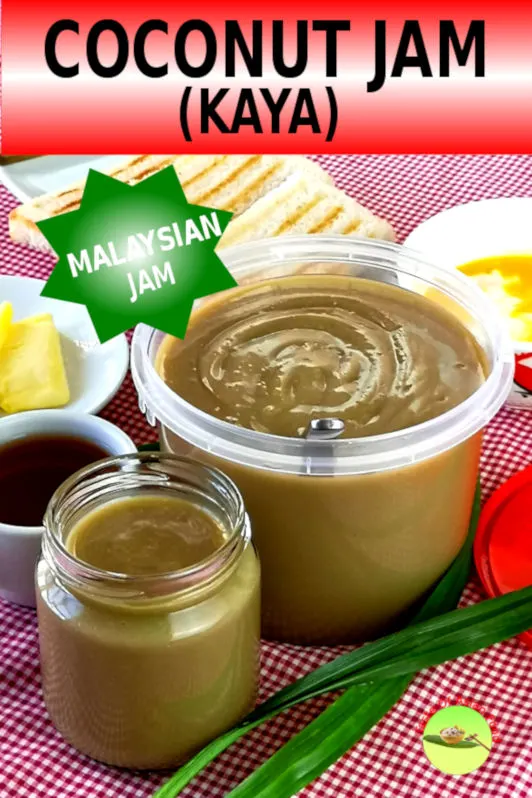
Note: Kaya means ‘rich‘ in the Malay language. I think it suits kaya well as it has a richer flavor than other fruit jams. It is called coconut jam (or kaya jam) in English and is also known as srikaya in Indonesia.
Note: This post may contain affiliate links. Please read my privacy policy for more info. I may receive commissions for purchases made through links in this post. As an Amazon Associate, I earn from qualifying purchases.
Step 1. Prepare the egg
Let’s dive into the nitty-gritty of how to make the best kaya (coconut jam) with the step by step instructions.
- First, crack the eggs into a bowl.
- Beat the egg until the egg yolk and egg white becomes homogeneous.
- Filter the eggs through a wire mesh strainer. This step is aimed to remove any small lumps of egg whites, which will affect the smoothness of kaya.
Step 2. Prepare the pandan extract with coconut milk
Since this is a pandan kaya recipe, I will add some pandan leaves to perfume the coconut milk. You can omit it, but the coconut jam will turn out to be less flavorful. (This situation is similar to making a cake with or without vanilla).
There are two ways to get the pandan extract. Wash the pandan leaves and cut them into short pieces and proceed with one of the following ways.
- Pour the coconut milk into a food processor. Add the pandan leaves. Blend the pandan leaves with coconut milk. It will transform into a light green suspension. Strain the coconut milk to remove the pandan leaves. The coconut milk is now infused with the pandan flavor. This method yields a stronger extract, but it will contain some leaf powder that escapes the strainer.
- Place the cut pandan leaves and coconut milk in a bowl. Heat the coconut milk but do not boil it. Let the pandan leaves steep in the coconut milk for fifteen minutes. Discard the leaves. This method yields a milder extract but is free from the leaves, which produce a clear and smoother kaya.
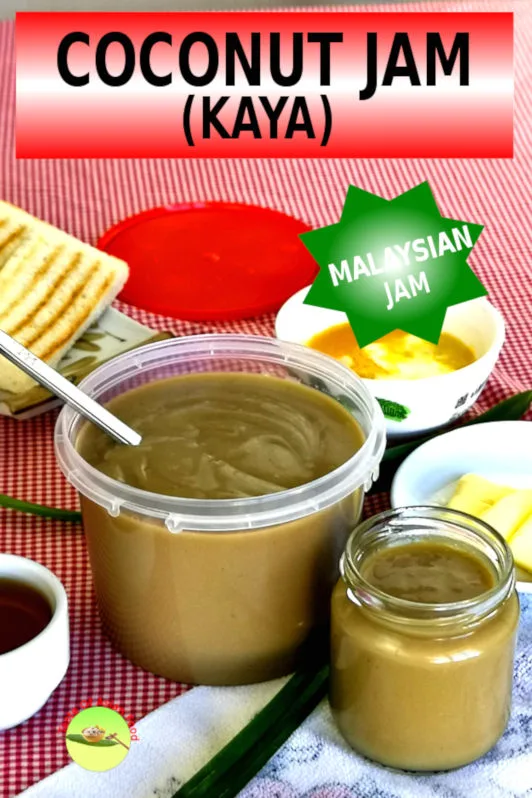
Step 3. Double-boiled all the ingredients
- Now add the coconut milk (which has extracted the pandan flavor) into the egg slowly. You may want to wait for a while if the coconut milk is still hot, This is because we do not want the heat from the coconut milk from cooking the egg at this moment. Combine well,
- Add the required amount of sugar to the filtered egg and coconut milk. It is alright if the sugar is not entirely dissolved as we will double boiled the mixture for about forty-five minutes.
- Put the bowl of the mixture over a pot of boiling water. Double boil it and stir from time to time to avoid overcooking the egg at the edges. As time goes by, the mixture will thicken when it starts to coagulates.
- I double boil the mixture so that the temperature is always below the boiling point. The temperature will take about twenty minutes (depends on the stove and the equipment you use) before reaching 75°C/170°F.
- If you have a kitchen thermometer, try to keep the temperature around this temperature at all times. The egg will start to thicken at this temperature.
- Now you can add the palm sugar.
- Continue cooking for another 45 minutes, and occasionally stir to prevent it becomes lumpy. You can cover the mixture to reduce the time required to return to 75°C/170°F. However, you still need to check every few minutes to ensure it is not overheated.
- Continue cooking until the mixture becomes smooth and creamy, and reaches the thickness that you want.
Note: If you cook the egg over higher temperatures, the mixture will become lumpy. In this case, the only way to salvage the pot of kaya is to process it with a food processor. However, the kaya will not look shiny anymore.
4. Blend the kaya
Blend the kay may not be the traditional method, but it is extremely effective to produce the kaya with a smooth texture.
Place the kaya in the food processor and blend it for about thirty seconds. Now it is all ready to serve or transfer to a bottle for storage.
Five tips to make the perfect kaya
If you have never make kaya before, I would strongly suggest you read this section before attempting this recipe. I have some tips to share, which I realize from my previous mistakes.
1. Use glassware or stainless steel pot with a thick base to double boil the kaya
I recommend you use either glass casserole or a stainless steel pot with a thick base to hold the kaya mixture. Both kitchenware will heat up slowly since they have higher heat capacity, and therefore the temperature will not rise abruptly and overcooked the egg.
If you use a stainless steel pot with a thin wall, the pot will heat up rapidly to above 75°C/170°F. Since egg will cook once it is heated to this temperature, the egg close to the edge of the pot will cook quicker than the center, resulting in the formation of pieces of cooked eggs. These small pieces of eggs are impossible to remove from the kaya. You can break them by blending the kaya, but since they are already solidified, the kaya will not be smooth.
2. Dilute the egg with coconut milk before starting the double-boiling process
I find that there are fewer chances of getting lumps if I dilute the egg with the coconut milk before heating up. I used to mix the egg with the sugar first, then double-boil the egg and sugar mixture until it started to coagulate before adding the coconut milk. However, it was challenging to keep the mixture free from lumps with my old method.
3. Steeping the pandan leaves in the coconut milk
Although steeping is less effective for extracting the pandan flavor than blending, I am in favor of the steeping method because the kaya is free from any fine leaf powder as a result of blending. This method is essential if you want a smooth kaya. Otherwise, go ahead to blend the leaves (then blend) to get a stronger pandan flavor.
4. You can make kaya without pandan leaves and palm sugar
You still can make the kaya without the pandan leaves and palm sugar. Pandan is like vanilla, which is nice to have but is not an essential item. As for the palm sugar, you can substitute it with some caramelized sugar.
5. Keep stirring
It is straightforward to make the jam. However, there are two tricks that you need to know if you want to make a perfect kaya. First, it requires patience to create an ideal coconut jam. Secondly, stir it constantly while cooking it over low heat to produce a smooth texture. If the result happened to become lumpy, transfer the kaya to the food processor and blend it until it is smooth.
How to store the kaya (coconut jam)
After the coconut jam is cold, transfer it into glass jars. This homemade kaya recipe does not contain preservatives. If you intend to freeze it, use the freezer-safe plastic containers. Kaya can be kept up to four days at room temperature, about two weeks in the refrigerator, and more than two months if frozen. Therefore, it is worthwhile to consider making a larger batch of kaya to save your time.
There you go. That’s how to make the Malaysian style pandan kaya!
Note: If you like this recipe, you make also like one of the most common Malaysian breakfast- Nasi lemak. You can get the recipe of nasi lemak here.
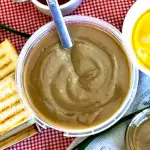
Kaya (Coconut Jam)
Whenever I think about kaya (coconut jam), it always conjured up flashes of childhood memories sitting in the old-school cafe eating Hainanese toast bread overflowing with kaya plus a piece of chilled butter.
Ingredients
- 450g eggs (about 9 medium size egg)
- 350g (12oz) white sugar
- 500g (2 cups) coconut milk
- 6 pandan leaves (about 20g)
- Palm sugar 80g (2.8 oz)
Instructions
- Beat the eggs in a bowl to combine the yolks and whites.
- Filter the egg with the wire mesh strainer.
- Heat the coconut milk, put the pandan leaves into the hot coconut milk. Steep the leaves for fifteen minutes.
- Discard the leaves and pour the coconut milk into the egg mixture.
- Add the white sugar.
- Double boil for forty-five minutes. Add the palm sugar when it is about to thicken. You can boil longer until it achieves the consistency you want.
- Blend the kaya with a blender or food processor for thirty seconds,
- Transfer the kaya to containers for storage.
Recommended Products
As an Amazon Associate and member of other affiliate programs, I earn from qualifying purchases.
-
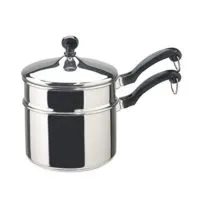 Farberware Classic Stainless Series 2-Quart Covered Double Boiler
Farberware Classic Stainless Series 2-Quart Covered Double Boiler -
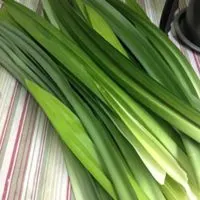 Fresh Pandan Leaves 4 oz. ( Rampe, La Dua, ใบเตยสด )
Fresh Pandan Leaves 4 oz. ( Rampe, La Dua, ใบเตยสด ) -
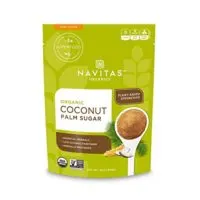 Navitas Organics Coconut Palm Sugar, 16 oz. Bag — Organic, Non-GMO, Gluten-Free, Sustainable
Navitas Organics Coconut Palm Sugar, 16 oz. Bag — Organic, Non-GMO, Gluten-Free, Sustainable -
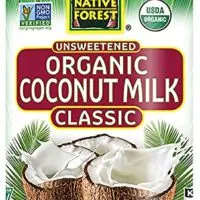 Native Forest Organic Classic Coconut Milk, 13.5 Ounce Cans (Pack of 12),Packaging may Vary
Native Forest Organic Classic Coconut Milk, 13.5 Ounce Cans (Pack of 12),Packaging may Vary
Nutrition Information:
Yield: 50 Serving Size: 20g per servingAmount Per Serving: Calories: 22Total Fat: 1gSaturated Fat: 0gTrans Fat: 0gUnsaturated Fat: 1gCholesterol: 34mgSodium: 15mgCarbohydrates: 2gFiber: 0gSugar: 2gProtein: 1g
This data was provided and calculated by Nutritionix on 11/28/2019

Kaya Toast Singapore: A Classic Breakfast with a Twist - SavorVoyage
Wednesday 27th of August 2025
[…] of this vibrant city-state. Traditionally crafted with thinly sliced toasted bread slathered in luscious coconut egg jam and a pat of creamy butter, this classic treat has recently undergone a flavorful evolution. In […]
Mei
Wednesday 26th of January 2022
Can I omit white sugar & use palm sugar instead? Also how to cut down on sugar in kaya.
KP Kwan
Wednesday 26th of January 2022
I would suggest omitting the white sugar and keeping the palm sugar. The total amount of sugar is reduced this way.
Wong Michael
Wednesday 17th of March 2021
Hii, I would like to know what the standard rational weight by percentage for the sugar, eggs and coconut milk to produce a good quality kaya. Thanks
KP Kwan
Friday 19th of March 2021
I am not aware of any standard ratio. I use 450g eggs, 430g sugar, and 500g coconut milk which is quite close to one part each.
Bonyan
Monday 30th of November 2020
Bonyan, 2020 November 29
Hi Kwan, I can’t get fresh coconut milk in Toronto, so I used can coconut milk, the kaya turned out great, but the coconut flavour wasn’t strong. My son said, is like eating egg sandwich.
KP Kwan
Monday 30th of November 2020
Haha I guess that's the best you can do with. Just one suggestion sometimes the terms coconut milk and cream (those in boxes) can be confusing. Should use those with coconut fat more than 20%, usually is written in the ingredient list or nutritional fact data.
Charina
Thursday 29th of October 2020
Pandan leaves are it readily available where I live. Do you think I could use bottled pandan extract?
KP Kwan
Friday 30th of October 2020
Hi Charina, You can use pandan extract whenever fresh leaves are not available. We also make the coconut jam by omitting the pandan leaves, and still tasty. KP Kwan